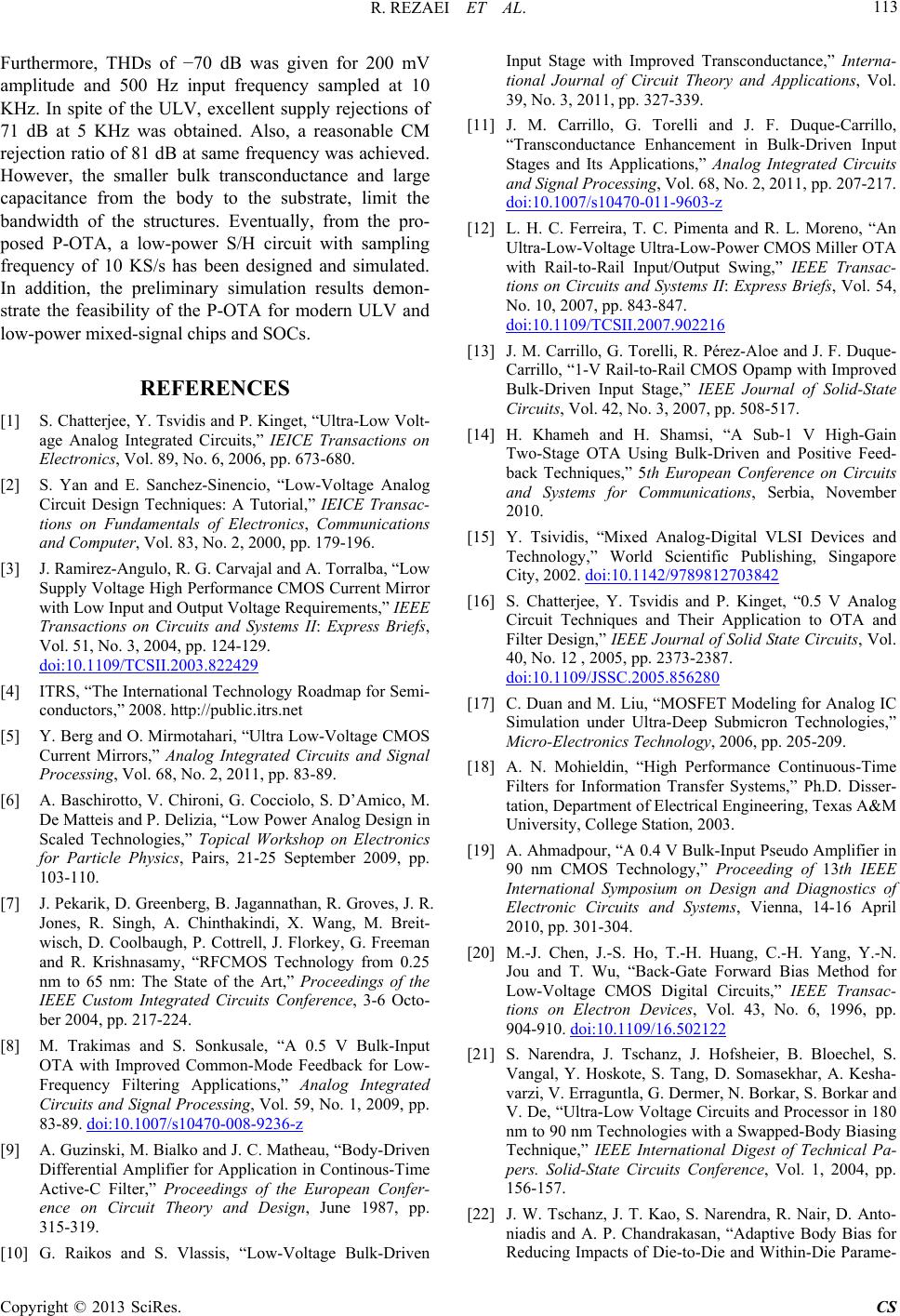
R. REZAEI ET AL. 113
Furthermore, THDs of 70 dB was given for 200 mV
amplitude and 500 Hz input frequency sampled at 10
KHz. In spite of the ULV, excellent supply rejections of
71 dB at 5 KHz was obtained. Also, a reasonable CM
rejection ratio of 81 dB at same frequency was achieved.
However, the smaller bulk transconductance and large
capacitance from the body to the substrate, limit the
bandwidth of the structures. Eventually, from the pro-
posed P-OTA, a low-power S/H circuit with sampling
frequency of 10 KS/s has been designed and simulated.
In addition, the preliminary simulation results demon-
strate the feasibility of the P-OTA for modern ULV and
low-power mixed-signal chips and SOCs.
REFERENCES
[1] S. Chatterjee, Y. Tsvidis and P. Kinget, “Ultra-Low Volt-
age Analog Integrated Circuits,” IEICE Transactions on
Electronics, Vol. 89, No. 6, 2006, pp. 673-680.
[2] S. Yan and E. Sanchez-Sinencio, “Low-Voltage Analog
Circuit Design Techniques: A Tutorial,” IEICE Transac-
tions on Fundamentals of Electronics, Communications
and Computer, Vol. 83, No. 2, 2000, pp. 179-196.
[3] J. Ramirez-Angulo, R. G. Carvajal and A. Torralba, “Low
Supply Voltage High Performance CMOS Current Mirror
with Low Input and Output Voltage Requirements,” IEEE
Transactions on Circuits and Systems II: Express Briefs,
Vol. 51, No. 3, 2004, pp. 124-129.
doi:10.1109/TCSII.2003.822429
[4] ITRS, “The International Technology Roadmap for Semi-
conductors,” 2008. http://public.itrs.net
[5] Y. Berg and O. Mirmotahari, “Ultra Low-Voltage CMOS
Current Mirrors,” Analog Integrated Circuits and Signal
Processing, Vol. 68, No. 2, 2011, pp. 83-89.
[6] A. Baschirotto, V. Chironi, G. Cocciolo, S. D’Amico, M.
De Matteis and P. Delizia, “Low Power Analog Design in
Scaled Technologies,” Topical Workshop on Electronics
for Particle Physics, Pairs, 21-25 September 2009, pp.
103-110.
[7] J. Pekarik, D. Greenberg, B. Jagannathan, R. Groves, J. R.
Jones, R. Singh, A. Chinthakindi, X. Wang, M. Breit-
wisch, D. Coolbaugh, P. Cottrell, J. Florkey, G. Freeman
and R. Krishnasamy, “RFCMOS Technology from 0.25
nm to 65 nm: The State of the Art,” Proceedings of the
IEEE Custom Integrated Circuits Conference, 3-6 Octo-
ber 2004, pp. 217-224.
[8] M. Trakimas and S. Sonkusale, “A 0.5 V Bulk-Input
OTA with Improved Common-Mode Feedback for Low-
Frequency Filtering Applications,” Analog Integrated
Circuits and Signal Processing, Vol. 59, No. 1, 2009, pp.
83-89. doi:10.1007/s10470-008-9236-z
[9] A. Guzinski, M. Bialko and J. C. Matheau, “Body-Driven
Differential Amplifier for Application in Continous-Time
Active-C Filter,” Proceedings of the European Confer-
ence on Circuit Theory and Design, June 1987, pp.
315-319.
[10] G. Raikos and S. Vlassis, “Low-Voltage Bulk-Driven
Input Stage with Improved Transconductance,” Interna-
tional Journal of Circuit Theory and Applications, Vol.
39, No. 3, 2011, pp. 327-339.
[11] J. M. Carrillo, G. Torelli and J. F. Duque-Carrillo,
“Transconductance Enhancement in Bulk-Driven Input
Stages and Its Applications,” Analog Integrated Circuits
and Signal Processing, Vol. 68, No. 2, 2011, pp. 207-217.
doi:10.1007/s10470-011-9603-z
[12] L. H. C. Ferreira, T. C. Pimenta and R. L. Moreno, “An
Ultra-Low-Voltage Ultra-Low-Power CMOS Miller OTA
with Rail-to-Rail Input/Output Swing,” IEEE Transac-
tions on Circuits and Systems II: Express Briefs, Vol. 54,
No. 10, 2007, pp. 843-847.
doi:10.1109/TCSII.2007.902216
[13] J. M. Carrillo, G. Torelli, R. Pérez-Aloe and J. F. Duque-
Carrillo, “1-V Rail-to-Rail CMOS Opamp with Improved
Bulk-Driven Input Stage,” IEEE Journal of Solid-State
Circuits, Vol. 42, No. 3, 2007, pp. 508-517.
[14] H. Khameh and H. Shamsi, “A Sub-1 V High-Gain
Two-Stage OTA Using Bulk-Driven and Positive Feed-
back Techniques,” 5th European Conference on Circuits
and Systems for Communications, Serbia, November
2010.
[15] Y. Tsividis, “Mixed Analog-Digital VLSI Devices and
Technology,” World Scientific Publishing, Singapore
City, 2002. doi:10.1142/9789812703842
[16] S. Chatterjee, Y. Tsvidis and P. Kinget, “0.5 V Analog
Circuit Techniques and Their Application to OTA and
Filter Design,” IEEE Journal of Solid State Circuits, Vol.
40, No. 12 , 2005, pp. 2373-2387.
doi:10.1109/JSSC.2005.856280
[17] C. Duan and M. Liu, “MOSFET Modeling for Analog IC
Simulation under Ultra-Deep Submicron Technologies,”
Micro-Electronics Technology, 2006, pp. 205-209.
[18] A. N. Mohieldin, “High Performance Continuous-Time
Filters for Information Transfer Systems,” Ph.D. Disser-
tation, Department of Electrical Engineering, Texas A&M
University, College Station, 2003.
[19] A. Ahmadpour, “A 0.4 V Bulk-Input Pseudo Amplifier in
90 nm CMOS Technology,” Proceeding of 13th IEEE
International Symposium on Design and Diagnostics of
Electronic Circuits and Systems, Vienna, 14-16 April
2010, pp. 301-304.
[20] M.-J. Chen, J.-S. Ho, T.-H. Huang, C.-H. Yang, Y.-N.
Jou and T. Wu, “Back-Gate Forward Bias Method for
Low-Voltage CMOS Digital Circuits,” IEEE Transac-
tions on Electron Devices, Vol. 43, No. 6, 1996, pp.
904-910. doi:10.1109/16.502122
[21] S. Narendra, J. Tschanz, J. Hofsheier, B. Bloechel, S.
Vangal, Y. Hoskote, S. Tang, D. Somasekhar, A. Kesha-
varzi, V. Erraguntla, G. Dermer, N. Borkar, S. Borkar and
V. De, “Ultra-Low Voltage Circuits and Processor in 180
nm to 90 nm Technologies with a Swapped-Body Biasing
Technique,” IEEE International Digest of Technical Pa-
pers. Solid-State Circuits Conference, Vol. 1, 2004, pp.
156-157.
[22] J. W. Tschanz, J. T. Kao, S. Narendra, R. Nair, D. Anto-
niadis and A. P. Chandrakasan, “Adaptive Body Bias for
Reducing Impacts of Die-to-Die and Within-Die Parame-
Copyright © 2013 SciRes. CS